Effects of Two Kinds of Commercial Organic Fertilizers on Growth and Rhizosphere Soil Properties of Corn on New Reclamation Land
Abstract
1. Introduction
2. Materials and Methods
2.1. Experimental Design
2.2. Measure of Corn Production and Soil
2.3. Soil Genome Sequencing and Analysis
2.3.1. Collection of Rhizosphere Samples and DNA Extraction
2.3.2. Soil Genome Sequencing
2.4. Statistical Analysis
3. Results and Discussion
3.1. Effects of Two Kinds of Commercial Organic Fertilizers on Corn Production
3.2. Effects of Two Kinds of Commercial Organic Fertilizers on Soil pH, Organic Matter Contents, and Nutrient Elements
3.3. The Effect of Two Kinds of Commercial Organic Fertilizers in Microbial Community Diversity
3.4. The Effect of Two Kinds of Commercial Organic Fertilizers in Soil Microbial Community Structure
3.5. The Effect of Two Kinds of Commercial Organic Fertilizers in the Rhizosphere Microbiome and Biomarker
3.6. The Effect of Two Kinds of Commercial Organic Fertilizers on RDA of Soil Properties and Mibrobial Communities
4. Conclusions
Supplementary Materials
Author Contributions
Funding
Institutional Review Board Statement
Informed Consent Statement
Data Availability Statement
Conflicts of Interest
References
- Ghose, B. Food security and food self-sufficiency in China: From past to 2050. Food Energy Secur. 2014, 3, 86–95. [Google Scholar] [CrossRef]
- Wang, Z.; Shen, Q.Y.; Shen, J.G.; Zhu, J.; Ma, W.H.; Yang, Y.M. Investigation on soil physical and chemical properties of new cultivated land in Yuhang District and improvement measures. Zhejiang Agric. Sci. 2017, 58, 1467–1470. (In Chinese) [Google Scholar]
- Li, X.; Su, Y.; Ahmed, T.; Ren, H.; Javed, M.R.; Yao, Y.; An, Q.; Yan, J.; Li, B. Effects of Different Organic Fertilizers on Improving Soil from Newly Reclaimed Land to Crop Soil. Agriculture 2021, 11, 560. [Google Scholar] [CrossRef]
- Li, X.; Li, D.; Lu, Q.; Wang, D.; Ren, X.; Lv, L.; Ahmed, T.; Yan, J.; Li, B. Effects of different organic fertilizers on sweet potato growth and rhizosphere soil properties in newly reclaimed land. Agronomy 2022, 12, 1649. [Google Scholar] [CrossRef]
- Hu, G.C.; Chen, D.H.; Huang, X.P.; Zhou, C.H.; Yu, G.R.; Pan, J.L. The research about balance system of farm land in occupation and supplement: A demonstration from Lin’ancity. J. Agric. 2014, 4, 112–115. [Google Scholar]
- Liu, Z.; Cao, S.L.; Sun, Z.H.; Wang, H.Y.; Qu, S.D.; Lei, N.; He, J.; Dong, Q.G. Tillage effects on soil properties and crop yield after land reclamation. Sci. Rep. 2021, 11, 4611. [Google Scholar] [CrossRef] [PubMed]
- Zhu, Q.; Hu, Z.Q.; Liu, X.R.; Wu, Y.J. Topsoil alternatives selection for surface coal-mined land reclamation in Inner Mongolia, China: An experimental study. Int. J. Min. Reclam. Environ. 2021, 35, 421–434. [Google Scholar] [CrossRef]
- Xu, Y.; Pu, L.J.; Zhang, R.S.; Zhu, M.; Zhang, M.; Bu, X.G.; Xie, X.F.; Wang, Y. Effects of agricultural reclamation on soil physicochemical properties in the mid-eastern coastal area of China. Land 2021, 10, 142. [Google Scholar] [CrossRef]
- Zhang, H. A Study on the Characters, Comprehensive Functions and Mechanisms of the Biological-Organic-Inorganic Compound Fertilizer. Ph.D. Thesis, China Agricultural University, Beijing, China, 2002. (In Chinese). [Google Scholar]
- Wang, J.; Yan, X.; Gong, W. Effect of long-term fertilization on soil productivity on the north china plain. Pedosphere 2015, 25, 450–458. [Google Scholar] [CrossRef]
- Han, J.P.; Shi, J.C.; Zeng, L.Z.; Xu, J.M.; Wu, L.S. Effects of nitrogen fertilization on the acidity and salinity of greenhouse soils. Environ. Sci. Pollut. Res. 2015, 22, 2976–2986. [Google Scholar] [CrossRef]
- Yin, C.; Fan, F.L.; Song, A.L.; Cui, P.Y.; Li, T.Q.; Liang, Y.C. Denitrification potential under different fertilization regimes is closely coupled with changes in the denitrifying community in a black soil. Appl. Microbiol. Biotechnol. 2015, 99, 5719–5729. [Google Scholar] [CrossRef]
- Song, X.H.; Xie, K.; Zhao, H.B.; Li, Y.L.; Dong, C.X.; Xu, Y.C.; Shen, Q.R. Effects of Different Organic Fertilizers on Tree Growth, Yield, Fruit Quality, and Soil Microorganisms in a Pear Orchard. Eur. J. Hortic. Sci. 2012, 77, 204–210. [Google Scholar]
- Larney, F.J.; Angers, D.A. The role of organic amendments in soil reclamation: A review. Can. J. Soil Sci. 2012, 92, 19–38. [Google Scholar] [CrossRef]
- Baran, A.; Mierzwa-Hersztek, M.; Gondek, K.; Tarnawski, M.; Szara, M.; Gorczyca, O.; Koniarz, T. The influence of the quantity and quality of sediment organic matter on the potential mobility and toxicity of trace elements in bottom sediment. Environ. Geochem. Health 2019, 41, 2893–2910. [Google Scholar] [CrossRef]
- Wu, L.Y.; Wen, C.Q.; Qin, Y.J.; Yin, H.Q.; Tu, Q.C.; Nostrand, J.D.V.; Yuan, T.; Yuan, M.T.; Deng, Y.; Zhou, J.Z. Phasing amplicon sequencing on Illumina Miseq for robust environmental microbial community analysis. BMC Microbiol. 2015, 15, 125. [Google Scholar] [CrossRef]
- Ren, H.; Wang, H.; Yu, Z.; Zhang, S.; Qi, X.; Sun, L.; Wang, Z.; Zhang, M.; Ahmed, T.; Li, B. Effect of Two Kinds of Fertilizers on Growth and Rhizosphere Soil Properties of Bayberry with Decline Disease. Plants 2021, 10, 2386. [Google Scholar] [CrossRef]
- Jiang, H.; Lv, L.; Ahmed, T.; Jin, S.; Shahid, M.; Noman, M.; Osman, H.-E.H.; Wang, Y.; Sun, G.; Li, X.; et al. Nanoparticles-Mediated Amelioration of Tomato Bacterial Wilt Disease by Modulating the Rhizosphere Bacterial Community. Int. J. Mol. Sci. 2022, 23, 414. [Google Scholar] [CrossRef]
- Martin, M. Cut adapt removes adapter sequences from high-throughput sequencing reads. EMBnet. J. 2011, 17, 10–12. [Google Scholar] [CrossRef]
- Reyon, D.; Tsai, S.Q.; Khayter, C.; Foden, J.A.; Sander, J.D.; Joung, J.K. FLASH assembly of TALENs for high-throughput genome editing. Nat. Biotechnol. 2012, 30, 460–465. [Google Scholar] [CrossRef]
- Rognes, T.; Flouri, T.; Nichols, B.; Quince, C.; Mahé, F. VSEARCH: A versatile open source tool for metagenomics. PeerJ 2016, 4, e2584. [Google Scholar] [CrossRef]
- Caporaso, J.G.; Kuczynski, J.; Stombaugh, J.; Bittinger, K.; Bushman, F.D.; Costello, E.K.; Fierer, N.; Peña, A.G.; Goodrich, J.K.; Gordon, J.I. QIIME allows analysis of high-throughput community sequencing data. Nat. Methods 2010, 7, 335–336. [Google Scholar] [CrossRef]
- Wang, Q.; Garrity, G.M.; Tiedje, J.M.; Cole, J.R. Naive Bayesian classifier for rapid assignment of rRNA sequences into the new bacterial taxonomy. Appl. Environ. Microbiol. 2007, 73, 5261–5267. [Google Scholar] [CrossRef]
- Lobo, I. Basic Local Alignment Search Tool (BLAST). J. Mol. Biol. 2008, 215, 403–410. [Google Scholar]
- Song, Z.W.; Gao, H.J.; Zhu, P.; Peng, C.; Deng, A.X.; Zheng, C.Y.; Mannaf, M.A.; Islam, M.N.; Zhang, W.J. Organic amendments increase corn yield by enhancing soil resilience to climate change. Crop J. 2015, 3, 110–117. [Google Scholar] [CrossRef]
- Nedunchezhiyan, M.; Sinhababu, D.P.; Sahu, P.K. Effect of soil amendments and irrigation regimes on minimum tillage planted sweet potato (Ipomoea batatas) in rice (Oryza sativa) fallows under lowland conditions. Indian J. Agric. Sci. 2014, 84, 371–375. [Google Scholar]
- Li, X.; Lu, Q.; Li, D.; Wang, D.; Ren, X.; Yan, J.; Ahmed, T.; Li, B. Effects of different microbial fertilizers on growth and rhizosphere soil properties of corn in newly reclaimed land. Plants 2022, 11, 1978. [Google Scholar] [CrossRef] [PubMed]
- Ali, L.; Manzoor, N.; Li, X.; Naveed, M.; Nadeem, S.; Waqas, M.; Khalid, M.; Abbas, A.; Ahmed, T.; Li, B.; et al. Impact of Corn Cob-Derived Biochar in Altering Soil Quality, Biochemical Status and Improving Maize Growth under Drought Stress. Agronomy 2021, 11, 2300. [Google Scholar] [CrossRef]
- Ren, H.Y.; Wang, H.Y.; Qi, X.J.; Yu, Z.P.; Zheng, X.L.; Zhang, S.W.; Wang, Z.S.; Zhang, M.C.; Ahmed, T.; Li, B. The Damage Caused by Decline Disease in Bayberry Plants through Changes in Soil Properties, Rhizosphere Microbial Community Structure and Metabolites. Plants 2021, 10, 2083. [Google Scholar] [CrossRef]
- Zhang, S.; Wang, R.; Yang, X.; Sun, B.; Li, Q. Soil aggregation and aggregating agents as affected by long term contrasting management of an Anthrosol. Sci. Rep. 2016, 6, 39107. [Google Scholar] [CrossRef]
- Asghar, W.; Kataoka, R. Green manure incorporation accelerates enzyme activity, plant growth, and changes in the fungal community of soil. Arch. Microbiol. 2022, 204, 7. [Google Scholar] [CrossRef]
- Still, S.M. Yield Comparison of Sweet Potatoes Grown in Four Commercial Organic Soils. HortScience 2019, 54, S236. [Google Scholar]
- Bednik, M.; Medyńska-Juraszek, A.; Dudek, M.; Kloc, S.; Kręt, A.; Łabaz, B.; Waroszewski, J. Wheat straw biochar and NPK fertilization efficiency in sandy soil reclamation. Agronomy 2020, 10, 496. [Google Scholar] [CrossRef]
- Xie, X.; Xiang, Q.; Wu, T.; Zhu, M.; Xu, F.; Xu, Y.; Pu, L. Impacts of Agricultural Land Reclamation on Soil Nutrient Contents, Pools, Stoichiometry, and Their Relationship to Oat Growth on the East China Coast. Land 2021, 10, 355. [Google Scholar] [CrossRef]
- Merzlaya, G.E.; Afanasiev, R.A. Agrochemical Aspects of Using Sewage Sludge for Reclamation of Land for Various Purposes. Agrokhimiya 2020, 8, 70–77. [Google Scholar]
- Tenic, E.; Ghogare, R.; Dhingra, A. Biochar—A panacea for agriculture or just carbon? Horticulturae 2020, 6, 37. [Google Scholar] [CrossRef]
- Lim, S.-S.; Yang, H.I.; Park, H.-J.; Park, S.-I.; Seo, B.-S.; Lee, K.-S.; Lee, S.-H.; Lee, S.-M.; Kim, H.-Y.; Ryu, J.-H. Land-use management for sustainable rice production and carbon sequestration in reclaimed coastal tideland soils of South Korea: A review. Soil Sci. Plant Nutr. 2020, 66, 60–75. [Google Scholar] [CrossRef]
- Criquet, S.; Braud, A. Effects of organic and mineral amendments on available P and phosphatase activities in a degraded Mediterranean soil under short-term incubation experiment. Soil Tillage Res. 2008, 98, 164–174. [Google Scholar] [CrossRef]
- Fan, T.; Stewart, B.A.; Wang, Y.; Luo, J.; Zhou, G. Long-term fertilization effects on grain yield, water-use efficiency and soil fertility in the dryland of Loess Plateau in China. Agric. Ecosyst. Environ. 2005, 106, 313–329. [Google Scholar] [CrossRef]
- Zhang, H.M.; Wang, B.R.; Xu, M.G.; Fan, T.L. Crop yield and soil responses to long-term fertilization on a red soil in Southern China. Pedosphere 2009, 19, 199–207. [Google Scholar] [CrossRef]
- Sogi, D.S.; Siddiq, M.; Dolan, K.D. Total phenolics, carotenoids and antioxidant properties of tommy atkin mango cubes as affected by drying techniques. LWT Food Sci. Technol. 2015, 62, 564–568. [Google Scholar] [CrossRef]
- Qu, B.P.; Liu, Y.X.; Sun, X.Y.; Li, S.Y.; Wang, S.Y.; Xiong, K.Y.; Yun, B.H.; Zhang, H. Effect of various mulches on soil physicochemical properties and tree growth (Sophora japonica) in urban tree pits. PLoS ONE 2019, 14, e0210777. [Google Scholar] [CrossRef]
- Mendes, G.D.O.; Freitas, A.L.M.; Pereira, O.L.; Silva, I.R.; Vassilev, N.B.; Costa, M.D. Mechanisms of phosphate solubilization by fungal isolates when exposed to different P sources. Ann. Microbiol. 2014, 64, 239–249. [Google Scholar] [CrossRef]
- Ikram, M.; Ali, N.; Jan, G.; Jan, F.G.; Rahman, I.U.; Iqbal, A.; Hamayun, M. IAA producing fungal endophyte Penicillium roqueforti Thom., enhances stress tolerance and nutrients uptake in wheatplants grown on heavy metal contaminated soils. PLoS ONE 2018, 13, e0208150. [Google Scholar] [CrossRef]
- Chowdappa, S.; Jagannath, S.; Konappa, N.; Udayashankar, A.C.; Jogaiah, S. Detection and characterization of antibacterial siderophores secreted by endophytic fungi from Cymbidium aloifolium. Biomolecules 2020, 10, 1412. [Google Scholar] [CrossRef] [PubMed]
- Li, X.; Yan, J.; Li, D.; Jiang, Y.; Zhang, Y.; Wang, H.; Zhang, J.; Ahmed, T.; Li, B. Isolation and Molecular Characterization of Plant-Growth-Promoting Bacteria and Their Effect on Eggplant (Solanum melongena) Growth. Agriculture 2021, 11, 1258. [Google Scholar] [CrossRef]
- Jiang, S.Q.; Yu, Y.N.; Gao, R.W.; Wang, H.; Zhang, J.; Li, R.; Long, X.H.; Shen, Q.R.; Chen, W.; Cai, F. High-throughput absolute quantification sequencing reveals the effect of different fertilizer applications on bacterial community in a tomato cultivated coastal saline soil. Sci. Total Environ. 2019, 687, 601–609. [Google Scholar] [CrossRef] [PubMed]
- Xun, W.B.; Liu, Y.P.; Li, W.; Ren, Y.; Xiong, W.; Xu, Z.H.; Zhang, N.; Miao, Y.Z.; Shen, Q.R.; Zhang, R.F. Specialized metabolic functions of keystone taxa sustain soil microbiome stability. Microbiome 2021, 9, 35. [Google Scholar] [CrossRef] [PubMed]
- Park, D.; Kim, H.; Yoon, S. Nitrous oxide reduction by an obligate aerobic bacterium, Gemmatimonasaurantiaca strain T-27. Appl. Environ. Microbiol. 2017, 83, e502–e517. [Google Scholar] [CrossRef]
- Chee-Sanford, J.; Tian, D.; Sanford, R. Consumption of N2O and other N-cycle intermediates by Gemmatimonasaurantiaca strain T-27. Microbiol. SGM 2019, 165, 1345–1354. [Google Scholar] [CrossRef]
- Jiang, X.M.; Zhang, F.H.; Li, J.H.; Fan, H.; Cheng, Z.B.; Wang, K.Y. Effects of bio-organic fertilizer on soil microbiome against Verticilliumdahliae. Int. J. Agric. Biol. 2016, 18, 923–931. [Google Scholar]
- Temple, T.N.; Thompson, E.C.; Uppala, S.; Granatstein, D.; Johnson, K.B. Floral colonization dynamics and specificity of Aureobasidium pullulans strains used to suppress fire blight of pome fruit. Plant Dis. 2020, 104, 121–128. [Google Scholar] [CrossRef]
- Ibrahim, E.; Zhang, M.; Zhang, Y.; Hossain, A.; Qiu, W.; Chen, Y.; Wang, Y.; Wu, W.; Sun, G.; Li, B. Green-synthesization of silver nanoparticles using endophytic bacteria isolated from garlic and its antifungal activity against wheat Fusarium head blight pathogen Fusarium graminearum. Nanomaterials 2020, 10, 219. [Google Scholar] [CrossRef]
- Li, X.; Li, D.; Yan, J.; Zhang, Y.; Wang, H.; Zhang, J.; Ahmed, T.; Li, B. Effect of Plant-Growth-Promoting Fungi on Eggplant (Solanum melongena L.) in New Reclamation Land. Agriculture 2021, 11, 1036. [Google Scholar] [CrossRef]

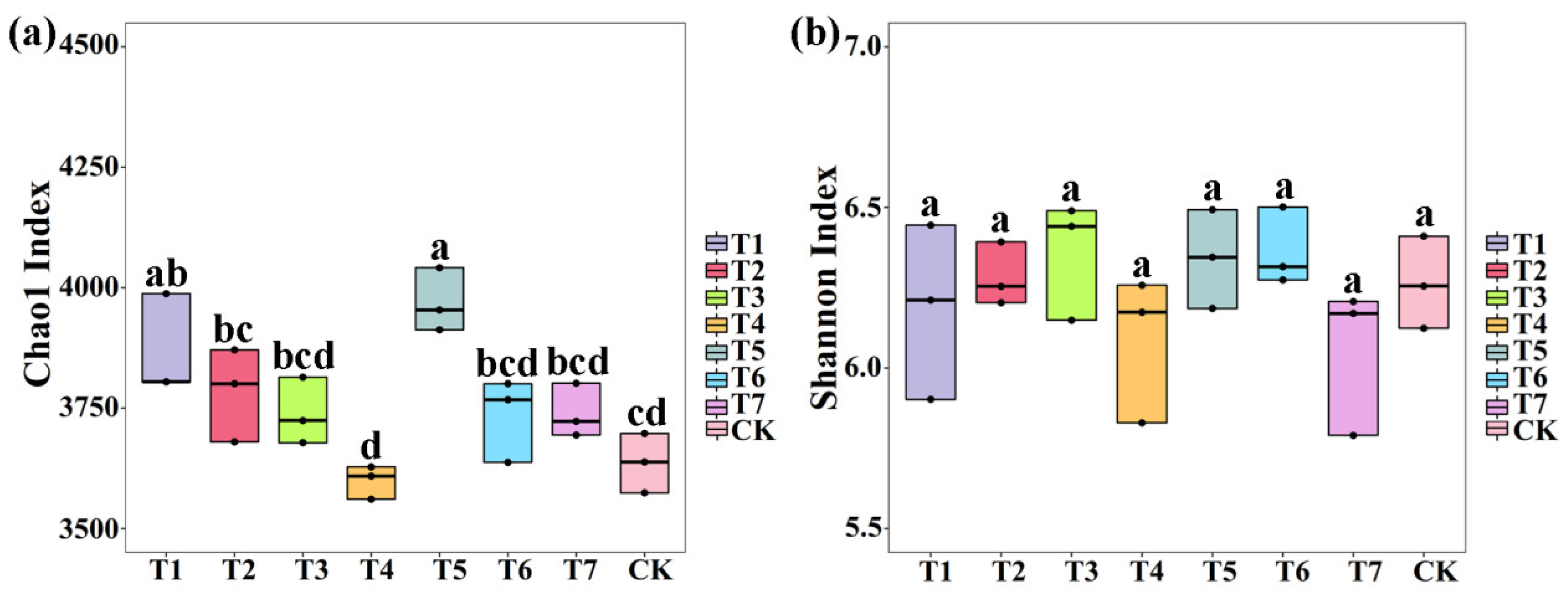

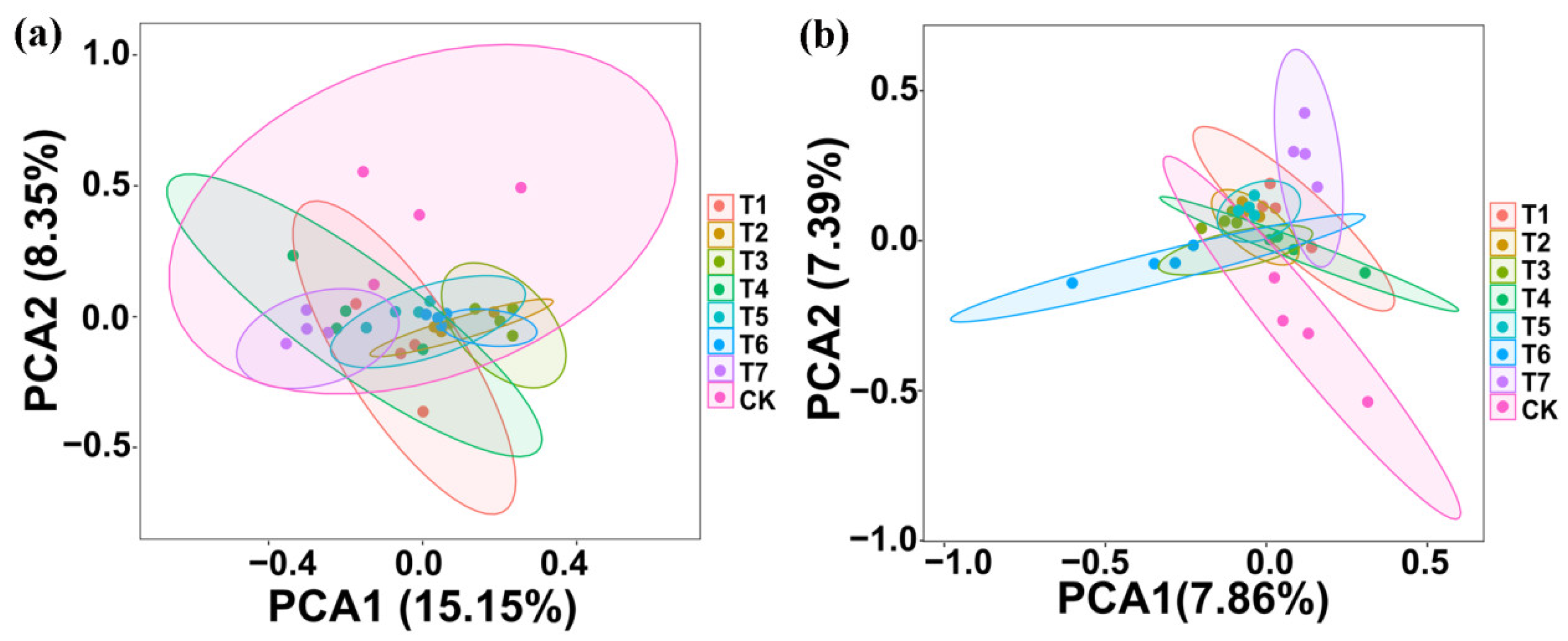
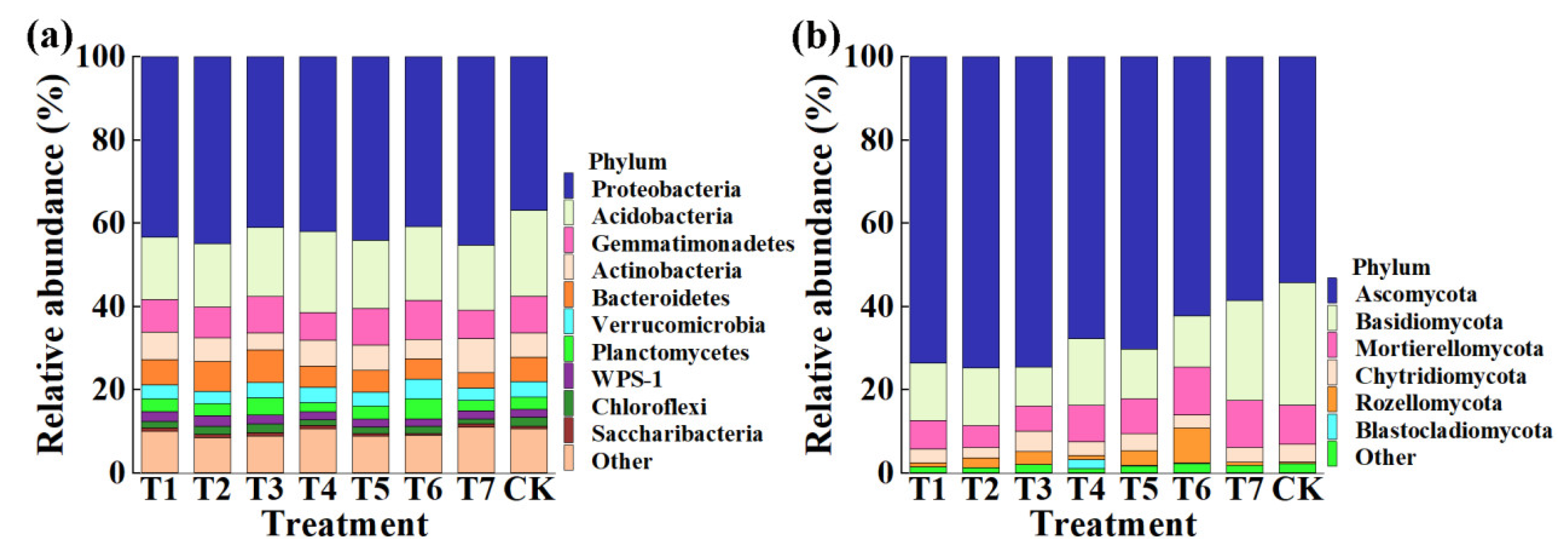

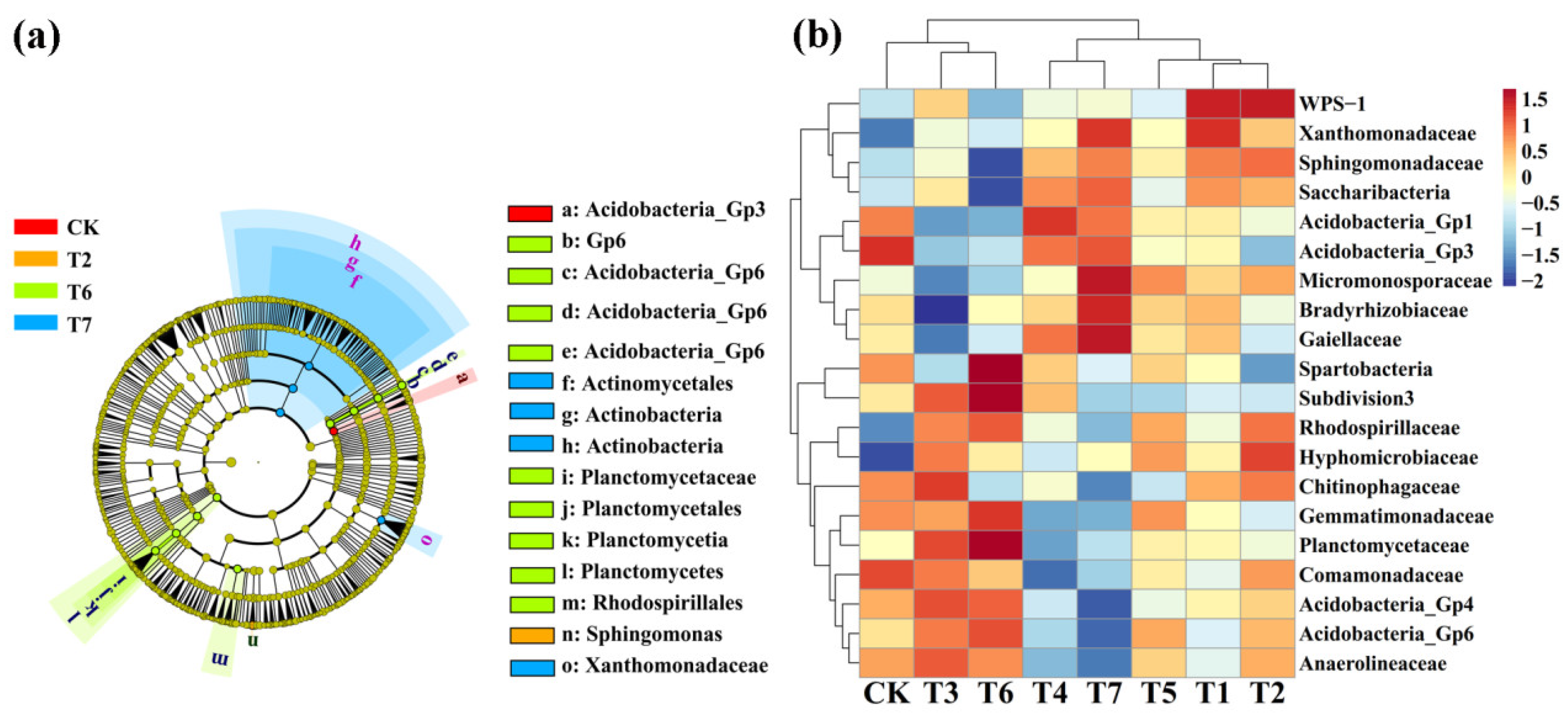
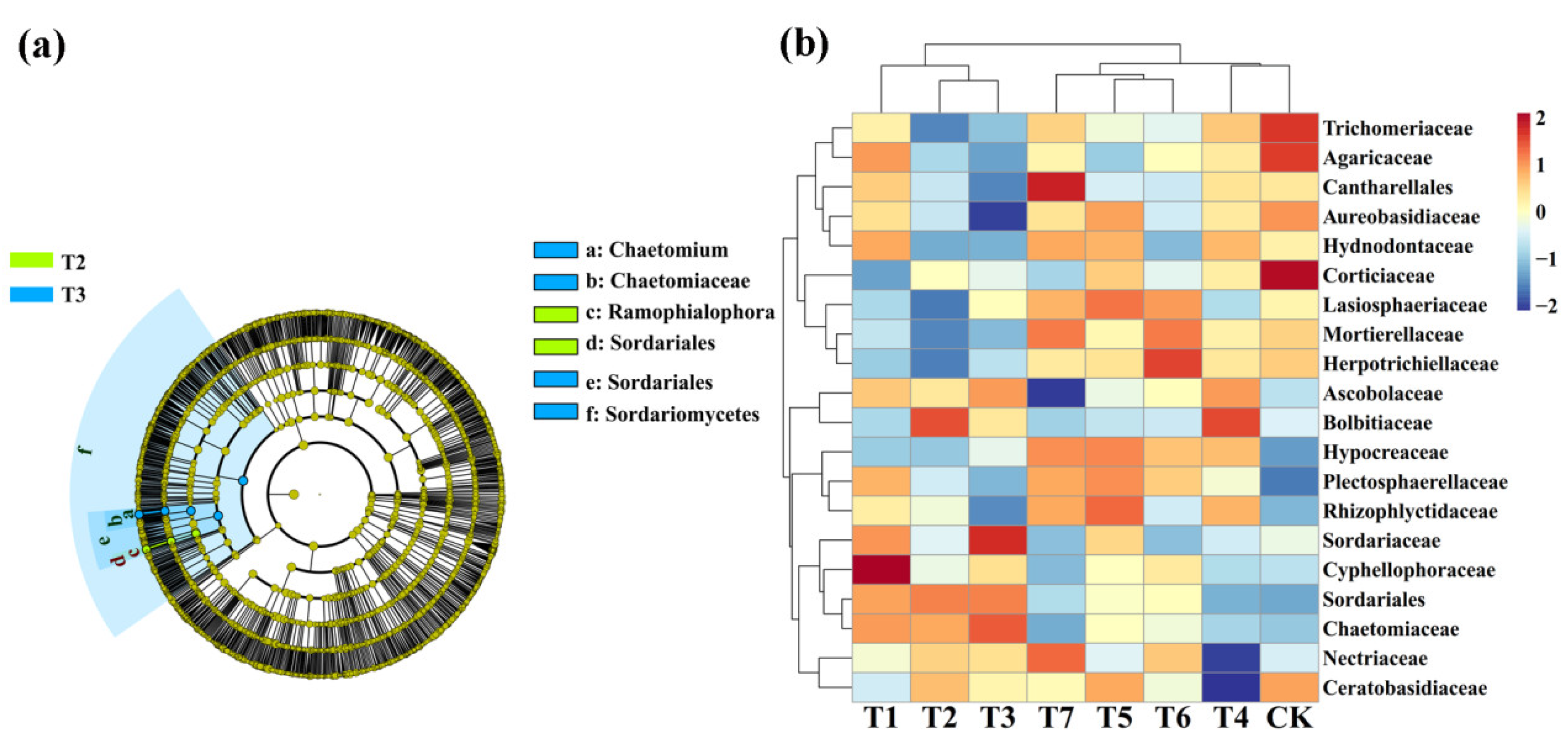
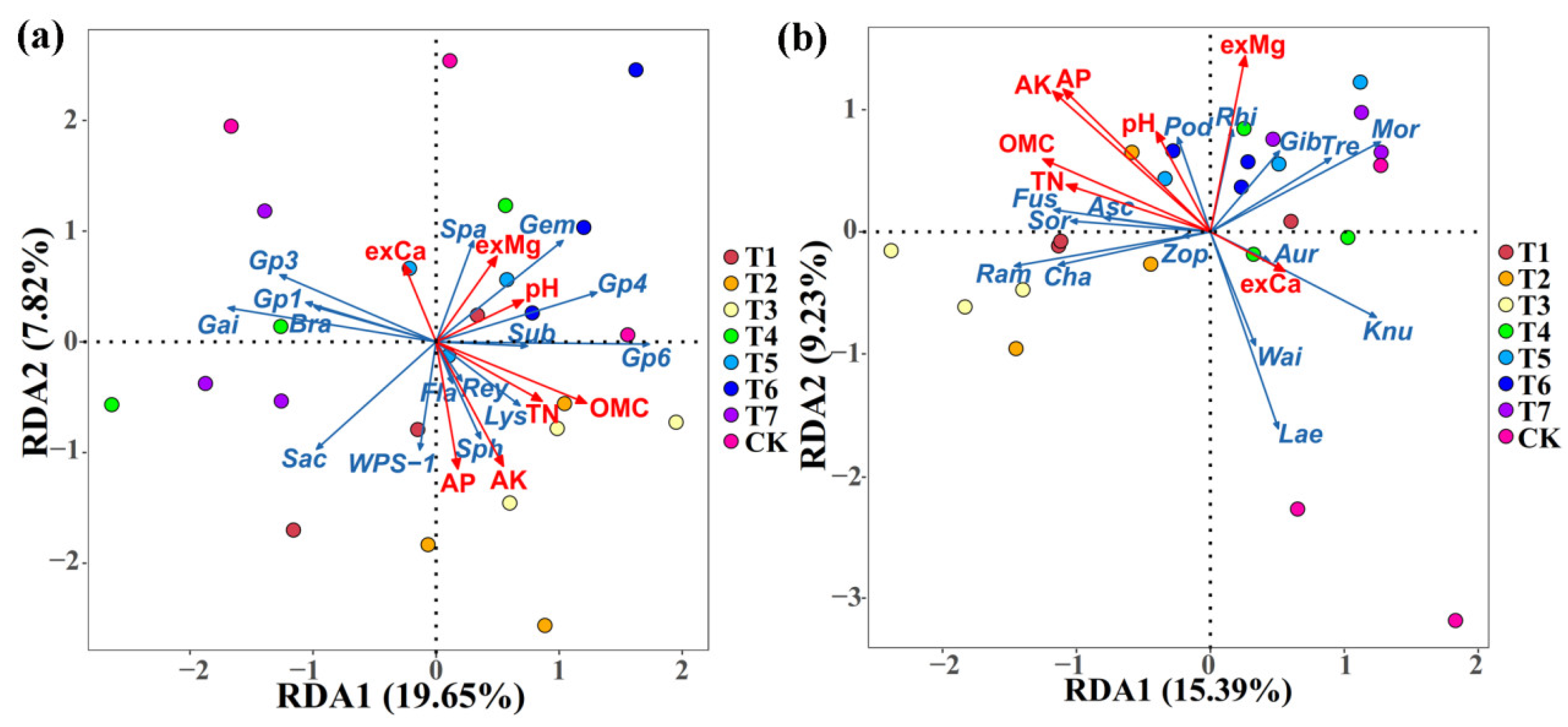
| Fertilizers | pH | OMC | NPK Content | Treatments | Concentration (kg/m2) |
|---|---|---|---|---|---|
| PMMR–OF | 8.4 | 57.4% | 8.9% | T1 | 0.90 |
| T2 | 1.35 | ||||
| T3 | 1.80 | ||||
| SM–OF | 7.8 | 65.8% | 6.5% | T4 | 0.75 |
| T5 | 1.05 | ||||
| T6 | 1.35 | ||||
| CCF | 4.5 | 48.0% | T7 | 0.075 | |
| Control | T8 | – |
| Treatments (kg/m2) | Weight of Air-Dried Corn Ears (kg/plot) | |||||
|---|---|---|---|---|---|---|
| 2019 | GPE% | 2020 | GPE% | 2021 | GPE% | |
| PMMR-OF (0.90) | 17.27 ± 1.64 | 12.23 b | 20.25 ± 1.98 | 33.67 a | 26.23 ± 1.00 | 79.90 a |
| PMMR-OF (1.35) | 17.99 ± 0.83 | 19.17 ab | 18.58 ± 0.93 | 22.67 ab | 26.45 ± 0.50 | 81.38 a |
| PMMR-OF (1.80) | 19.64 ± 1.18 | 30.12 a | 19.56 ± 1.56 | 29.14 a | 25.83 ± 1.31 | 77.16 a |
| SM-OF (0.75) | 17.29 ± 1.39 | 14.58 b | 17.77 ± 0.86 | 17.32 ab | 26.00 ± 0.73 | 78.29 a |
| SM-OF (1.05) | 17.43 ± 0.99 | 15.46 b | 17.80 ± 1.48 | 17.51 ab | 26.32 ± 0.49 | 80.52 a |
| SM-OF (1.35) | 18.66 ± 0.50 | 23.63 ab | 20.09 ± 0.69 | 32.60 a | 23.60 ± 0.52 | 61.87 b |
| CCF (0.075) | 17.83 ± 1.31 | 18.11 ab | 16.67 ± 0.98 | 10.03 b | 21.21 ± 1.79 | 45.44 c |
| Control | 15.09 ± 0.56 | – | 15.15 ± 1.13 | – | 14.58 ± 0.71 | – |
| Treatments (kg/m2) | pH | OMC (g/kg) | ||||
|---|---|---|---|---|---|---|
| 2019 | 2020 | 2021 | 2019 | 2020 | 2021 | |
| PMMR-OF (0.90) | 5.79 ± 0.27 a | 6.40± 0.93 a | 6.18± 0.47 a | 13.42± 0.32 a | 13.95± 1.92 ab | 14.77± 1.41 c |
| PMMR-OF (1.35) | 5.76± 0.20 a | 6.64± 0.39 a | 5.95± 0.43 a | 12.72± 1.12 a | 15.13± 0.08 ab | 16.23± 0.65 abc |
| PMMR-OF (1.80) | 5.76 ± 0.62 a | 6.16 ± 0.14 a | 5.99± 0.32 a | 13.68 ± 0.69 a | 16.31 ± 1.27 a | 17.14 ± 0.07 ab |
| SM-OF (0.75) | 5.40± 0.17 a | 5.88± 0.68 a | 6.01 ± 0.21 a | 12.21 ± 0.89 ab | 13.57 ± 0.97 b | 15.87 ± 0.76 bc |
| SM-OF (1.05) | 5.54± 0.12 a | 6.13± 0.09 a | 6.23 ± 0.15 a | 12.41 ± 1.02 ab | 14.03 ± 1.20 ab | 16.12 ± 0.53 abc |
| SM-OF (1.35) | 5.46± 0.07 a | 6.10± 0.17 a | 6.28 ± 0.06 a | 13.23 ± 0.53 a | 16.20 ± 1.35 a | 17.67 ± 0.83 a |
| CCF (0.075) | 5.61± 0.42 a | 5.92± 0.20 a | 6.04 ± 0.33 a | 10.53± 1.86 bc | 10.57± 1.19 c | 11.21± 1.29 d |
| Control | 5.59 ± 0.53 a | 5.90 ± 0.26 a | 5.92 ± 0.40 a | 9.80 ± 0.76 c | 10.82 ± 1.03 c | 10.08 ± 0.26 d |
| Treatments (kg/m2) | Total N (g/kg) | Available P (mg/kg) | Available K (mg/kg) | ||||||
|---|---|---|---|---|---|---|---|---|---|
| 2019 | 2020 | 2021 | 2019 | 2020 | 2021 | 2019 | 2020 | 2021 | |
| PMMR-OF (0.90) | 0.74 ± 0.08 a | 0.88 ± 0.06 a | 0.99 ± 0.10 a | 7.93 ± 0.36 a | 12.37 ± 1.05 b | 17.80 ± 1.11 ab | 438.55 ± 9.38 ab | 438.14 ± 8.11 ab | 473.62 ± 9.37 ab |
| PMMR-OF (1.35) | 0.73 ± 0.05 a | 0.87 ± 0.10 a | 1.03 ± 0.21 a | 8.03 ± 0.30 a | 13.76 ± 0.44 ab | 18.40 ± 0.82 ab | 420.74 ± 7.39 c | 443.27 ± 7.83 a | 473.59 ± 6.26 ab |
| PMMR-OF (1.80) | 0.70 ± 0.08 a | 0.88 ± 0.08 a | 1.06 ± 0.10 a | 7.72 ± 0.75 abc | 13.64 ± 0.72 ab | 18.93 ± 0.69 a | 426.88 ± 3.55 bc | 444.12 ± 6.47 a | 480.04 ± 4.05 a |
| SM-OF (0.75) | 0.74 ± 0.09 a | 0.83 ± 0.07 a | 1.04 ± 0.16 a | 7.11 ± 0.96 cd | 12.94 ± 0.98 ab | 18.93 ± 0.45 a | 376.87 ± 9.41 d | 440.72 ± 7.20 ab | 467.14 ± 5.02 b |
| SM-OF (1.05) | 0.74 ± 0.04 a | 0.89 ± 0.12 a | 1.05 ± 0.19 a | 7.83 ± 0.69 ab | 13.20 ± 1.22 ab | 17.53 ± 0.23 ab | 414.26 ± 6.03 c | 442.79 ± 9.08 a | 482.14 ± 6.54 a |
| SM-OF (1.35) | 0.78 ± 0.11 a | 0.88 ± 0.13 a | 1.06 ± 0.12 a | 7.09 ± 0.27 d | 13.93 ± 0.75 a | 17.43 ± 0.67 b | 384.06 ± 6.03 d | 426.56 ± 7.77 b | 475.58 ± 6.79 ab |
| CCF (0.075) | 0.73 ± 0.05 a | 0.74 ± 0.19 a | 0.81 ± 0.09 ab | 7.29 ± 0.60 bcd | 10.87 ± 0.21 c | 17.80 ± 0.79 ab | 449.67 ± 5.37 a | 452.70 ± 9.03 a | 449.84 ± 5.53 c |
| Control | 0.64 ± 0.05 a | 0.68 ± 0.06 a | 0.69 ± 0.05 b | 4.64± 0.52 e | 4.98 ± 0.55 d | 5.28 ± 0.56 c | 357.04 ± 8.33 e | 371.75 ± 5.80 c | 362.02 ± 2.25 d |
| Treatments (kg/m2) | Exchangeable Ca (cmol (1/2 Ca2+)/kg) | Exchangeable Mg (cmol (1/2 Mg2+)/kg) | ||||
|---|---|---|---|---|---|---|
| 2019 | 2020 | 2021 | 2019 | 2020 | 2021 | |
| PM-COF (0.90) | 16.43 ± 0.74 a | 13.93 ± 0.94 ab | 9.87 ± 1.12 a | 5.73 ± 0.28 a | 4.59 ± 0.80 a | 4.15 ± 0.15 a |
| PM-COF (1.35) | 14.98 ± 0.55 abc | 13.85 ± 1.78 ab | 8.78 ± 0.43 ab | 5.58 ± 0.10 a | 4.57 ± 0.62 a | 4.46 ± 0.79 a |
| PM-COF (1.80) | 15.09 ± 0.90 abc | 14.29 ± 1.74 a | 8.03 ± 0.56 b | 5.70 ± 0.05 a | 4.88 ± 0.36 a | 4.36 ± 0.39 a |
| SM-COF (0.75) | 12.64 ± 1.16 d | 11.46 ± 0.53 b | 8.68 ± 0.95 ab | 5.57 ± 0.41 a | 4.42 ± 0.94 a | 4.78 ± 0.43 a |
| SM-COF (1.05) | 14.61 ± 1.22 abcd | 14.90 ± 0.38 a | 9.41 ± 0.60 ab | 5.62 ± 0.23 a | 4.79 ± 0.34 a | 4.97 ± 0.14 a |
| SM-COF (1.35) | 15.23 ± 1.65 ab | 13.64 ± 1.27 ab | 9.18 ± 0.80 ab | 5.78 ± 0.09 a | 4.90 ± 0.54 a | 5.00 ± 0.01 a |
| CCF (0.075) | 13.87 ± 1.46 bcd | 12.43 ± 0.88 ab | 8.83 ± 0.31 ab | 5.41 ± 0.55 a | 4.83 ± 0.60 a | 4.66 ± 0.57 a |
| Control | 13.06 ± 0.93 cd | 13.62 ± 1.34 ab | 9.59 ± 0.51 a | 5.44 ± 0.24 a | 5.03 ± 0.03 a | 4.22 ± 0.99 a |
| Soil Environment | Contribution at Bacterial Genus Level (%) | Contribution at Fungal Genus Level (%) |
|---|---|---|
| pH | 10.71 | 20.43 |
| organic matter contents | 30.75 | 41.90 |
| total N | 17.32 | 27.94 |
| available P | 20.05 | 60.46 |
| available K | 24.00 | 63.13 |
| exchangeable Ca | 8.50 | 9.20 |
| exchangeable Mg | 12.85 | 52.00 |
Publisher’s Note: MDPI stays neutral with regard to jurisdictional claims in published maps and institutional affiliations. |
© 2022 by the authors. Licensee MDPI, Basel, Switzerland. This article is an open access article distributed under the terms and conditions of the Creative Commons Attribution (CC BY) license (https://creativecommons.org/licenses/by/4.0/).
Share and Cite
Li, X.; Lu, Q.; Li, D.; Wang, D.; Ren, X.; Yan, J.; Ahmed, T.; Li, B. Effects of Two Kinds of Commercial Organic Fertilizers on Growth and Rhizosphere Soil Properties of Corn on New Reclamation Land. Plants 2022, 11, 2553. https://doi.org/10.3390/plants11192553
Li X, Lu Q, Li D, Wang D, Ren X, Yan J, Ahmed T, Li B. Effects of Two Kinds of Commercial Organic Fertilizers on Growth and Rhizosphere Soil Properties of Corn on New Reclamation Land. Plants. 2022; 11(19):2553. https://doi.org/10.3390/plants11192553
Chicago/Turabian StyleLi, Xuqing, Qiujun Lu, Dingyi Li, Daoze Wang, Xiaoxu Ren, Jianli Yan, Temoor Ahmed, and Bin Li. 2022. "Effects of Two Kinds of Commercial Organic Fertilizers on Growth and Rhizosphere Soil Properties of Corn on New Reclamation Land" Plants 11, no. 19: 2553. https://doi.org/10.3390/plants11192553
APA StyleLi, X., Lu, Q., Li, D., Wang, D., Ren, X., Yan, J., Ahmed, T., & Li, B. (2022). Effects of Two Kinds of Commercial Organic Fertilizers on Growth and Rhizosphere Soil Properties of Corn on New Reclamation Land. Plants, 11(19), 2553. https://doi.org/10.3390/plants11192553







